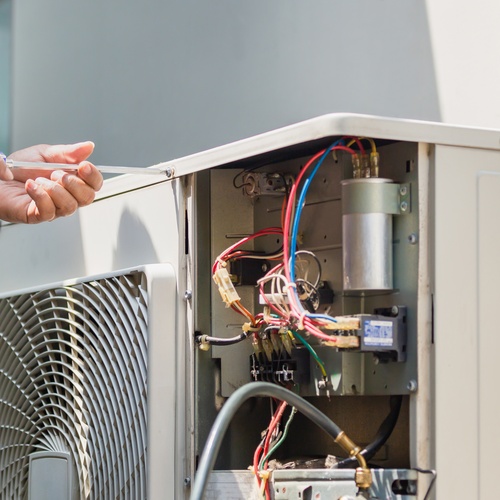Air conditioners keep us cool during the summer. But when they start acting up, temperatures can quickly rise in more ways than one. Before calling professional help, you can often sort out common AC hiccups with DIY troubleshooting. Read on to discover how to help with DIY troubleshooting for common air conditioner issues.
AC Not Cooling
When your air conditioner blows warm air, it’s tempting to panic. Start with the thermostat. Confirm you set the temperature correctly and that the unit is in cooling mode. A misprogrammed thermostat is a common culprit.
Next, turn your attention to the air filter. A dirty filter blocks airflow, making it tough for the AC to cool effectively. Swap out the old filter for a clean one and test the system again.
The outdoor unit deserves attention, too. Leaves, dirt, or debris often clog the condenser coils, reducing the system’s efficiency. Carefully clear the area around the outdoor unit and clean any visible debris on the coils. Regular HVAC maintenance is beneficial in preventing cooling issues.
AC Turns On and off Frequently
If your air conditioner cycles on and off constantly, it’s not just annoying; it’s also bad for the system. A clogged air filter may be the root of the problem. Restricted airflow puts unnecessary stress on the unit, forcing it to work harder than it should. Replacing the filter can often restore functionality.
Blocked vents are another suspect. Walk through your space and inspect all the vents to confirm they’re open and unobstructed. Furniture or drapes can limit airflow, causing the system to cycle inefficiently.
Look at the capacitor for a more technical fix, which supplies the necessary energy to your AC’s motor. A faulty or failing capacitor can lead to frequent cycling. While replacing a capacitor may require extra confidence, many DIYers find it straightforward.
AC Leaking Water
Discovering that your air conditioner is leaking water can feel like a disaster waiting to happen. Though dramatic, it often has an easy fix. A clogged condensate drain line is frequently to blame. Over time, dust, algae, or debris can block this drain, leading to water pooling around the unit. Use a wet-dry vacuum or a thin brush to clear the blockage. This simple task can save you from water damage and potential mold growth inside your home.
Also, remember to keep your AC unit properly maintained. Regular HVAC maintenance has the added benefit of discouraging clogs in your drain line and ensuring other components stay in working order.
AC Making Strange Noises
Bangs, rattles, or hissing sounds coming from your AC are cause for investigation. Loose parts often vibrate, creating unusual noises. Grab a screwdriver and go over the unit, tightening any screws or bolts you find.
There’s no need to panic if you hear the fan making noise. Turn off the system and inspect the fan blades. Occasionally, debris like sticks or leaves gets caught, causing the racket. Clean out anything obstructing the fan and restart your AC to see if that fixes the issue.
The compressor can also be a source of strange sounds. While you can visually inspect it, you should leave compressor repairs or replacements to professionals due to their complexity.
AC Smells Bad
A foul odor drifting from your air conditioner isn’t just unpleasant; it can signal an issue you shouldn’t ignore. A dirty air filter is often the culprit. Replace it regularly to improve airflow and eliminate musty smells.
Additionally, clogged or dirty ductwork can harbor mold and mildew, leading to unpleasant odors in your home. Grab your vacuum and clean the ducts within reach. For deeper grime, though, professional duct cleaning might be the way to go.
There’s no reason to sweat through summer with a misbehaving AC. Give these troubleshooting AC tips a go, and for expert assistance, reach out to a trusted HVAC professional when necessary. A cool and comfortable home is always worth the effort!

